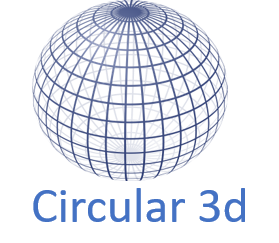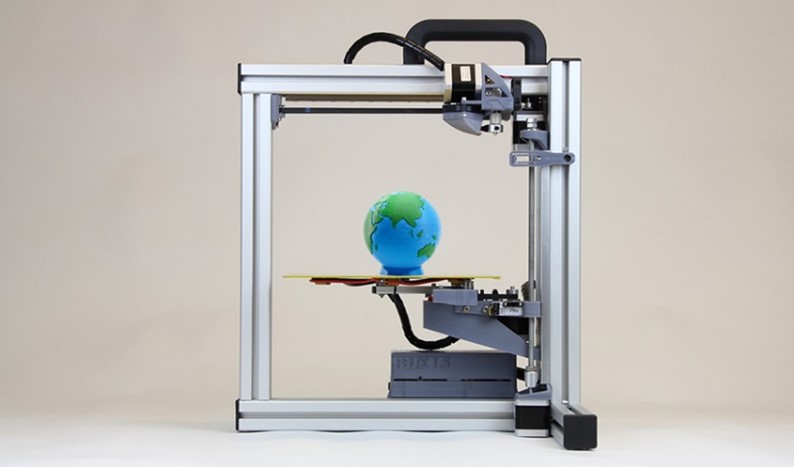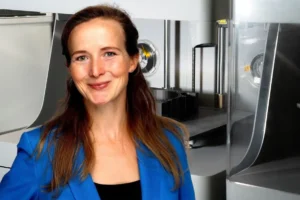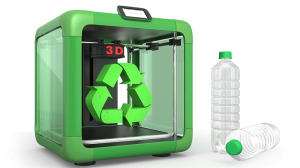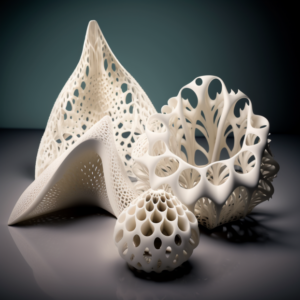Looking at the condition our world is in today and the massive challenges we are facing with global warming it becomes clear that we need a radical shift in our system.
Despite the 2016 signed Paris agreement, our global carbon emissions are increasing constantly. The plastic production is expected to double within few years with only 14 % being recycled.[1] 99 % of the things we produce are trashed within 6 months.[2]
The problem with our current linear model however is that it is fully build up on short term growth. We can’t expect the businesses to change their current business model because it is too aligned to how they operate, in short term earnings driven by their shareholder interests. Our full economy is build up on economies of scale. Maybe we can expect some experimentation and innovation along the edges but no real change of the current model and system. Instead, what is really needed is a disruptive business model and a disruptive technology that changes how we produce and use things.
We need to shift from mass production to individual production. Only 3d printing can enable this shift because other manufacturing technologies support the mass production model.
When talking about 3d printings impact on the manufacturing market and its disruption on the supply chain, I am regularly facing objections that 3d printing is pretty slow and expensive compared to traditional manufacturing. It’s true that traditional manufacturing, for many applications, is still faster and more affordable. But 3d Printing can convince with two other strong advantages and these are: design and digitization. With 3d printing you can create new forms and structures that were not possible before. And the digital nature of 3d printing allows us to innovate and adapt at these products at a much faster rate and to transfer and multiply these products in form of a file globally in a blink of an eye.

At the same time 3d Printing gets constantly faster and more affordable. With some printers it is already possible to print a bike frame within one hour. In this case, traditional manufacturing is not faster. And we need to remind ourselves that technological development is exponential but humans tend to think in a linear way. Also Ink Jet was once pretty slow, but today a color print only needs a few seconds.
As to be expected, the rate of technological progress is outpacing the ability of most companies to understand, deploy, and maximize new technology solutions in terms of operational benefits. That’s always the case with new technology. Remember the first incarnation of the Internet? Startups boomed, then collapsed as people and companies could not adapt to the Internet as fast as expected. But over the next 20 years, Internet commerce grew and prospered.
That will happen to today’s revolutionary manufacturing technology. Providers will simplify their solutions, and people will learn to manage the digital transformation.
If we look at the global manufacturing market, 3d printing is currently only 0.1 % of that. But as the technology is evolving, this portion will grow rapidly. In his article for the World Economic Forum, Ric Fulop points out that 3d printing is emerging in three distinct growth curves.[3]
Today, the industry stands at the beginning of a development, which will see wider adoption of 3D printing for manufacturing, forever changing the way products are made. Fulop states: “In this next decade for 3D printing, we are entering an exponential curve because the technology is more affordable, there are more use cases and more supply of raw materials, and that opens up the application space. This enables this new market, which is going from that early component now to end-use parts and spare parts.”

As you see in the graphic, we are standing at the start of a manufacturing revolution and we have to lay the right foundations for it now. This is so important because as we are looking back how fossil based plastics have evolved, it gets clear that the first years of material choices for a manufacturing technology are formative for their further development. The very first plastic was made from cellulose, the most abundant plant-based material on earth. But in the era of cheap oil, the development of fossil-based plastics were driven forward. Due to the scaling effect their price got constantly lower and reached a point where it was very hard for bioplastics to compete with them. And this is still the case today in the traditional manufacturing market. Due to economy of scale and the overwhelming amount of plastics in the world, the cost per part is very cheap. If we would consider all the consequential costs for our health and environment, plastic costs should be much higher, but the policy is not there yet. Considering that biomaterials are still a very small part of the overall plastics market and development costs are high, it can’t compete pricewise in the traditional manufacturing market. But when it comes to 3d printing, as the industry is still in its infancy, the cost for a spool of ABS is similar to a spool of PLA. On top of that, the bio alternative often brings additional advantages, like better printability. 3d Printing took a leading role in PLA, a plastic made from corn, and with growing environmental awareness among customers the demand for this material increased in the traditional manufacturing market, driving prices to a new high.
If it comes to engineering materials however, customers have a tendency, to buy what they are familiar with like ABS, Nylon, Peek etc., neglecting that there are alternatives. I personally spoke to experts of big industry players and often they were not even aware that biological alternatives exist. But once you explain it to them, they are very interested and want to learn more. One such material is Floreon, that is four times tougher than standard PLA.
That is why it is so important that 3d printing manufacturers are educating customers about these new materials and are not blindly following the demands of the customers. Companies that act on this first will gain a first mover advantage. Innovation happens with challenging the status quo and not by blindly following what others are doing.
Even if compared to traditional plastics, PLA and other biomaterials bring a much better carbon footprint, they are not the ultimate answer because these are chemically modified and do biodegrade only under certain industrial conditions. Plastic (biodegradable or not) is an artificial material and, as such, nature can’t understand nor assimilate it. That is why, it depends on human action to be recovered. As this is rarely happening, most of the plastic is harming us and our planet.
Therefore, we don’t need only a biodegradable plastic but materials that provide other models of manufacturing, using ingredients nature can understand and process on its own. We do not need a lot of materials, but the right ones. We need to integrate our manufacturing with the ecology of earth.
The STUD team of the University of Singapore has produced from cellulose and chitin, the two most ubiquitous natural molecules on Earth, a material called FLAM.[4] These ingredients are common byproducts in industry and could potentially be used in every ecosystem on earth.
The resulting material was loaded into an ABB robotic arm and used to 3d print the 1.2 meter long turbine blade, weighing 5.2kg. FLAM has about the same cost as commodity plastics and is 10 times cheaper than common plastic filaments like ABS and PLA.

As cellulose and chitin can be sourced locally, they perfectly fit into a circular economy model that designs out waste, keeps materials in use at their highest value and regenerates natural systems. This economy is not only better for us and our environment, but is also a huge driver for growth, with the potential of creating a net benefit of 1.8 trillion by 2030, alone in Europe. That printing with organic materials seems to be a hot topic, is also been demonstrated by the rising number of patents. There have been 5,100 patents for 3D printing with cellulose since 2015.[5]
3d Printing, if used with the right foundational principles, has the technological capability for a new type of manufacturing process that can run on renewable energy and can recycle materials back into the system in a closed loop, resulting in a highly distributed model of production. Therefore, we need to strive for materials parsimony and add functionality through design like nature is doing it. Increasing computer power, innovative generative design tools as well as better and faster printers enable a new world of manufacturing.
Covid 19 only accelerates this development as its highlights the advantages of 3d printing with flexibility, innovation capability and decentralisation, aspects that gain huge importance during such a crisis.
With global temperatures on the rise, our impact on the planet has been like nothing it has ever seen. We are already on the brink of an ecological collapse. While the pandemic will end eventually, the effect of rising greenhouse gas emissions will intensify the climate crisis until businesses commit to lower emissions. And there will be no vaccine to protect us from the devastating consequences.

The way how we create things and the material choices we take have a huge impact on us and on our environment. Global manufacturing consumes about 54 % of the world’s total energy and a fifth of its GHG emissions.[6] Two thirds of all environmental damages are coming through the not correct use or overuse of materials. We must turn the tide now, there is no other way but to disrupt a global mechanism striving on carelessness and focused on maximizing production in favor of a more conscious solution. With 3d printing, the technology for future manufacturing, we have the power and the obligation to lay the foundation for it to be sustainable and ecological.
[1] 1 Ellenmacarthurfoundation: The new plastics Economy: Rethinking the future of Plastics & Catalysing Action
[2] The Story of Stuff: https://www.storyofstuff.org/
[3] World Economic Forum: These 4 simple solutions can help make the manufacturing industry more sustainable
[4] University of Singapore, https://epd.sutd.edu.sg
[5] 3ders: 3d Printer News
[6] https://www.eia.gov/outlooks/ieo/pdf/industrial.pdf and www.ellenmacarthurfoundation.org
